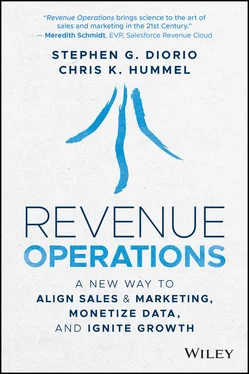Stephen Diorio - Revenue Operations
Здесь есть возможность читать онлайн «Stephen Diorio - Revenue Operations» — ознакомительный отрывок электронной книги совершенно бесплатно, а после прочтения отрывка купить полную версию. В некоторых случаях можно слушать аудио, скачать через торрент в формате fb2 и присутствует краткое содержание. Жанр: unrecognised, на английском языке. Описание произведения, (предисловие) а так же отзывы посетителей доступны на портале библиотеки ЛибКат.
- Название:Revenue Operations
- Автор:
- Жанр:
- Год:неизвестен
- ISBN:нет данных
- Рейтинг книги:3 / 5. Голосов: 1
-
Избранное:Добавить в избранное
- Отзывы:
-
Ваша оценка:
- 60
- 1
- 2
- 3
- 4
- 5
Revenue Operations: краткое содержание, описание и аннотация
Предлагаем к чтению аннотацию, описание, краткое содержание или предисловие (зависит от того, что написал сам автор книги «Revenue Operations»). Если вы не нашли необходимую информацию о книге — напишите в комментариях, мы постараемся отыскать её.
Revenue Operations: A New Way to Align Sales and Marketing, Monetize Data, and Ignite Growth
Revenue Operations
Revenue Operations
Revenue Operations — читать онлайн ознакомительный отрывок
Ниже представлен текст книги, разбитый по страницам. Система сохранения места последней прочитанной страницы, позволяет с удобством читать онлайн бесплатно книгу «Revenue Operations», без необходимости каждый раз заново искать на чём Вы остановились. Поставьте закладку, и сможете в любой момент перейти на страницу, на которой закончили чтение.
Интервал:
Закладка:
1 Eliminate revenue leakage across the revenue cycle by eliminating the handoffs and “air gaps” in the prospect-to-cash cycle to revenue and margin leakage with a single point of management of the customer journey across the enterprise. This revenue, margin, and price leakage can cost your company up to 5% of realized profits (EBITDA) on business you should already have, but fail to realize because of missed handoffs, lack of follow-up, and improper pricing. If you are a $100 million company, that translates to losses from $1 million to $5 million annually. Add in the opportunity cost of missing signals from new buyers, alerts from angry customers, and opportunities to expand accounts, and the impact is far bigger.
2 Enable scalable technologies that multiply your efforts by redeploying operations and analytics resources to create scalable and consistent growth including one-to-one personalization at scale, real-time training at scale, dynamic pricing, data-driven sales resource allocation, and account-based marketing. For example, using algorithms to enforce pricing discipline and dynamically match price to market demand can add 10 points of profit to your bottom line with no incremental resources or investment. A 1% increase in effective price with no commensurate volume loss will add 10% to your bottom-line profits, according to Professors Jagmohan Ragu and John Zhang at the Wharton School of Business. 102
3 Foster teamwork by doubling the engagement, speed, and productivity of revenue teams by adjusting the way they architect and systematize their selling systems, so they can grow faster while reducing the associated cost of sales. “Organizations that have automated workflow processes are seeing efficiency gains of two to three times when compared to counterparts using manual or spreadsheet-driven processes,” according to Michael Smith, a Managing Director of Blue Ridge Partners, who has helped over 300 B2B organizations unlock more growth from existing selling assets in the last decade.
4 Improve the return on technology assets by rationalizing the technology stack to reduce waste and sunset stranded or nonperforming assets. This will improve seller experience and adoption. Redeploying operations resources will streamline the administration of data, technology, and content. As we've discussed, these growth assets are expensive, valuable, and generate a significant portion of the financial value of your firm. In most firms they are underutilized and poorly managed. Putting these assets to work in ways that directly support scalable growth – such as better allocating resources and informing selling actions that yield higher prices, bigger deals, and better conversion rates – creates significant financial impact. For example, business-to-business selling organizations can get 50% higher engagement, speed of response and productivity from their sales reps at lower costs by incorporating virtual selling channels into their commercial model,” according to Michael Smith.
5 Use data to optimize selling and resource allocation by generating more and better insights from customer engagement and seller activity assets. Any business can better focus their selling time, resources, priorities, and the way they treat customers to make more money. The emergence of digital channels and advanced analytics offer tremendous potential to improve the performance of selling teams and channels. Businesses can realize these efficiencies by sharpening segmentation, focusing account priorities, shifting engagement to digital channels, and fine-tuning the emphasis and priorities of their sellers. We call the optimization of all these selling system design variables “the commercial architecture.” A properly designed and optimized commercial architecture that aligns selling roles, effort, and engagement with the right customers can contribute 5–10 points of profit contribution to the bottom line in the short term.
6 Reallocate sales overhead from real estate and travel to more scalable investments in training and enablement. The average organization spends over $10,000 a year on “selling overhead” on a per rep basis. Up until the mass adoption of work-at-home and work-from-anywhere policies, most of this overhead was associated with real estate, travel, and market development funds to take clients out to dinner. Very little – less than a third – was spent on scalable investments in training and technology to enable sellers. Replacing some or all of this overhead with technologies and training offers the potential to double visibility, speed, productivity, and engagement while still yielding a net reduction in cost of sell. Eighty-one percent of growth leaders surveyed by Wharton are actively optimizing that mix by increasing investment in digital technologies to improve market coverage and client engagement, while cutting travel and selling overhead budget to generate much higher sales at much lower costs. 5
7 Improve the economics of field selling by improving the speed of ramping sales reps, raising the overall level of readiness and skill across the entire revenue team, and reducing churn to retain top talent that performs at a high level. A 5% increase in sales rep attrition across your sales team can increase selling costs 4–6% and reduce total revenue attainment by 2–3% overall. 137For low-growth and low-margin companies, 10 points of salesforce attrition can wipe out revenue plans and margins if nobody picks up the slack. For instance, the difference between a 5% sales rep attrition rate and one of 25% means that your overall cost to sell increases by more than 50% and your revenue drops by 20%.
Eight Ways Revenue Operations Creates Financial Value
1 Monetize commercial assets. Putting your customer data, digital technology, and channel infrastructure assets to work in ways that create value – informing selling decisions, optimizing resource allocation, supporting higher prices, and better conversion rates – can grow revenues, profits, and firm value.
2 Manage the economics of selling. Simplifying the seller experience improves the economics of selling by streamlining and better supporting the day-to-day seller workflow. A less complex selling workflow will help you develop and retain talent, reduce selling costs, and improve the adoption of technology tools.
3 Differentiate the customer experience. Optimizing your commercial processes, portfolio of offerings, revenue team incentives, and enabling investments with a focus on differentiating the customer experience are fundamental to selling in a market where most buyers don't see a material difference between companies they buy from.
4 Enable scalable growth technologies. More centralized management and stewardship of enterprise data, technology, and content assets are essential to executing programs that multiply the efforts of every member of the revenue team, such as: one-to-one personalization, real-time coaching, response management, and account-based marketing capabilities.
5 Support recurring revenues. Creating a common purpose across the revenue team to grow customer lifetime value is essential to selling in a subscription, SaaS, and recurring revenue model.
6 Improve visibility into selling performance. Gaining access to real-time insights into account health, opportunity potential, and seller and pipeline performance is now essential to managing the performance of digital, displaced, diverse, and dynamic revenue teams.
7 Motivate team selling. All of the customer-facing employees across the sales, marketing, and customer-support teams need to be managed, measured, and incentivized as one revenue team focused on executing the corporate growth agenda and growing customer lifetime value.
8 Turn technology assets into force multipliers. Modern revenue teams have evolved to operate similar to an army that relies more on agile logistics and operational support infrastructure than individual heroics to be successful. One in four members of the revenue team are now in operations and enablement roles.
Читать дальшеИнтервал:
Закладка:
Похожие книги на «Revenue Operations»
Представляем Вашему вниманию похожие книги на «Revenue Operations» списком для выбора. Мы отобрали схожую по названию и смыслу литературу в надежде предоставить читателям больше вариантов отыскать новые, интересные, ещё непрочитанные произведения.
Обсуждение, отзывы о книге «Revenue Operations» и просто собственные мнения читателей. Оставьте ваши комментарии, напишите, что Вы думаете о произведении, его смысле или главных героях. Укажите что конкретно понравилось, а что нет, и почему Вы так считаете.











